How to Count Calories in Indian Home-Cooked Food? A Practical Guide
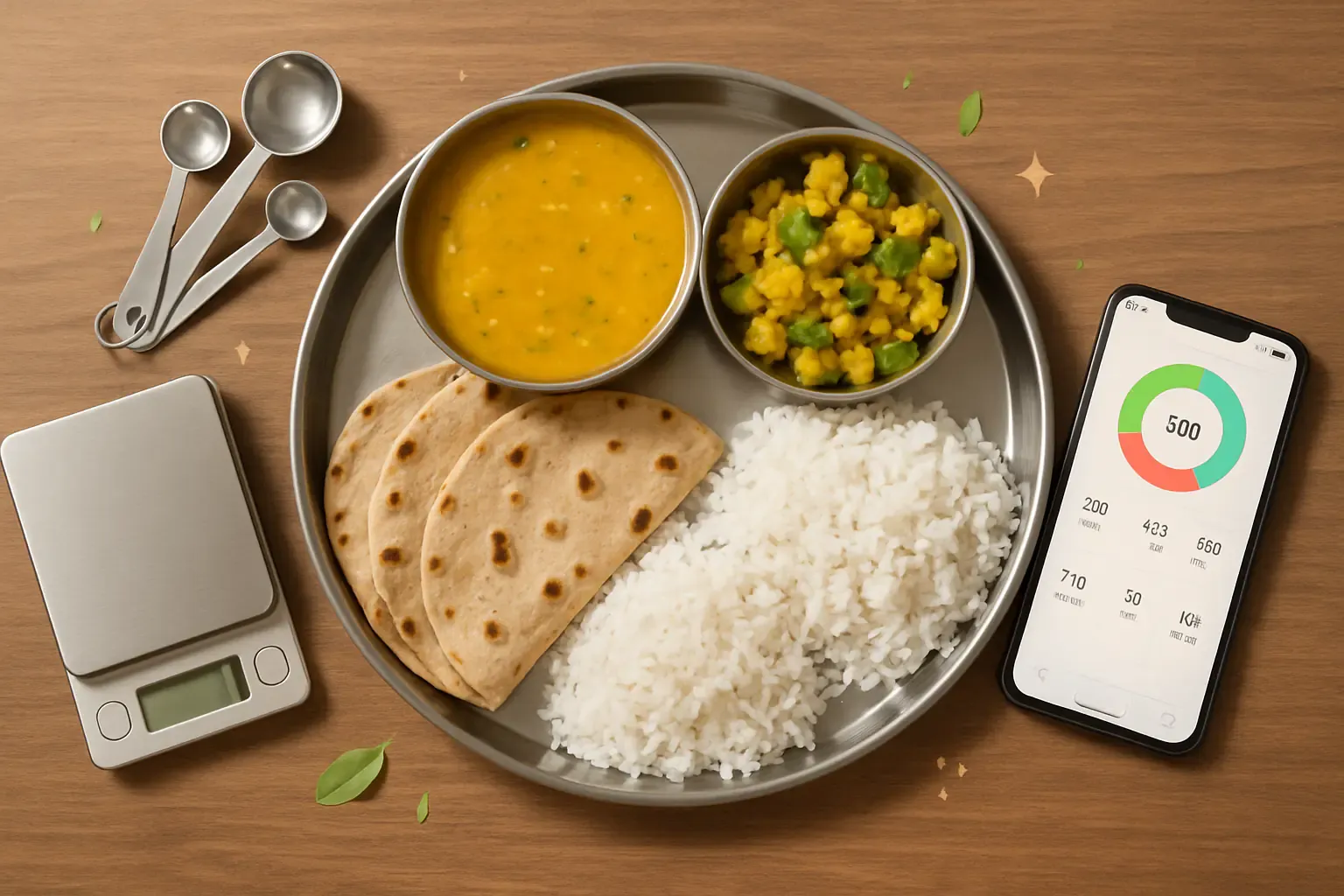
Have you ever sat down to a comforting plate of rajma chawal and wondered: "How can I possibly know the calories in this?" 🤔
TL;DR - Counting Calories in Indian Home-Cooked Food
• Who it's for: Indians wanting to track nutrition in traditional home-cooked meals for weight management or health goals
• Main outcomes: Accurate calorie tracking of complex Indian dishes, better portion control, sustainable weight loss with favorite foods
• Key steps: Learn basic measurements → Use online calorie calculator → Apply 70% rule for home cooking → Track with meal scanning → Build personal recipe database
• Timeframe: Master basics in 1-2 weeks, build confident tracking habits in 4-6 weeks, automate process in 2-3 months
• How NutriScan helps: AI recognizes Indian foods, accounts for cooking methods, provides portion guidance, and learns your family recipes
If you've nodded, even slightly, trust me, you are in the company of millions. It's a question that has crossed my mind more times than I can count on my own winding, and often confusing, health journey.
In a world full of fitness trackers and diet apps, tracking calories has become a go-to method for people wanting to take charge of their health. Whether your goal is shedding a few kilos, building lean muscle, or managing a health condition like diabetes, understanding your energy intake is a powerful first step. But here's the catch: most of this advice seems designed for a world of Caesar salads, grilled chicken breasts, and quinoa bowls.
What about our food? The food that is the centerpiece of our culture, our celebrations, and our daily lives. The food cooked with generations of love in our kitchens, bursting with complex spices and a kaleidoscope of ingredients. Tracking the nutrition in a simple dal tadka can feel more complex than rocket science.
But what if I told you it doesn't have to be? What if there was a way to decode your plate without losing the joy of eating?
The Delicious Dilemma: The Challenge of Indian Food 🥄
Let me share a story that might sound familiar. A few years ago, my good friend Rohan decided to get serious about his fitness. He was filled with a fiery motivation, downloaded a top-rated fitness app, and diligently began logging his meals. His breakfast, a simple toast with peanut butter, was easy to log.
But then came lunch. His mom, with all her love, had packed him her famous dal makhani and some fluffy jeera rice. He opened his app and searched for "dal makhani." The screen flooded with options. One entry, from a generic database, said 250 calories per serving. Another, from a restaurant chain, claimed 500 calories. His mom's version, with its secret blend of spices and a modest amount of cream, was nowhere to be found.
Which was right? The confusion quickly turned into frustration. After a week of this guessing game, he gave up, sighing, "It's just too hard for our kind of food."
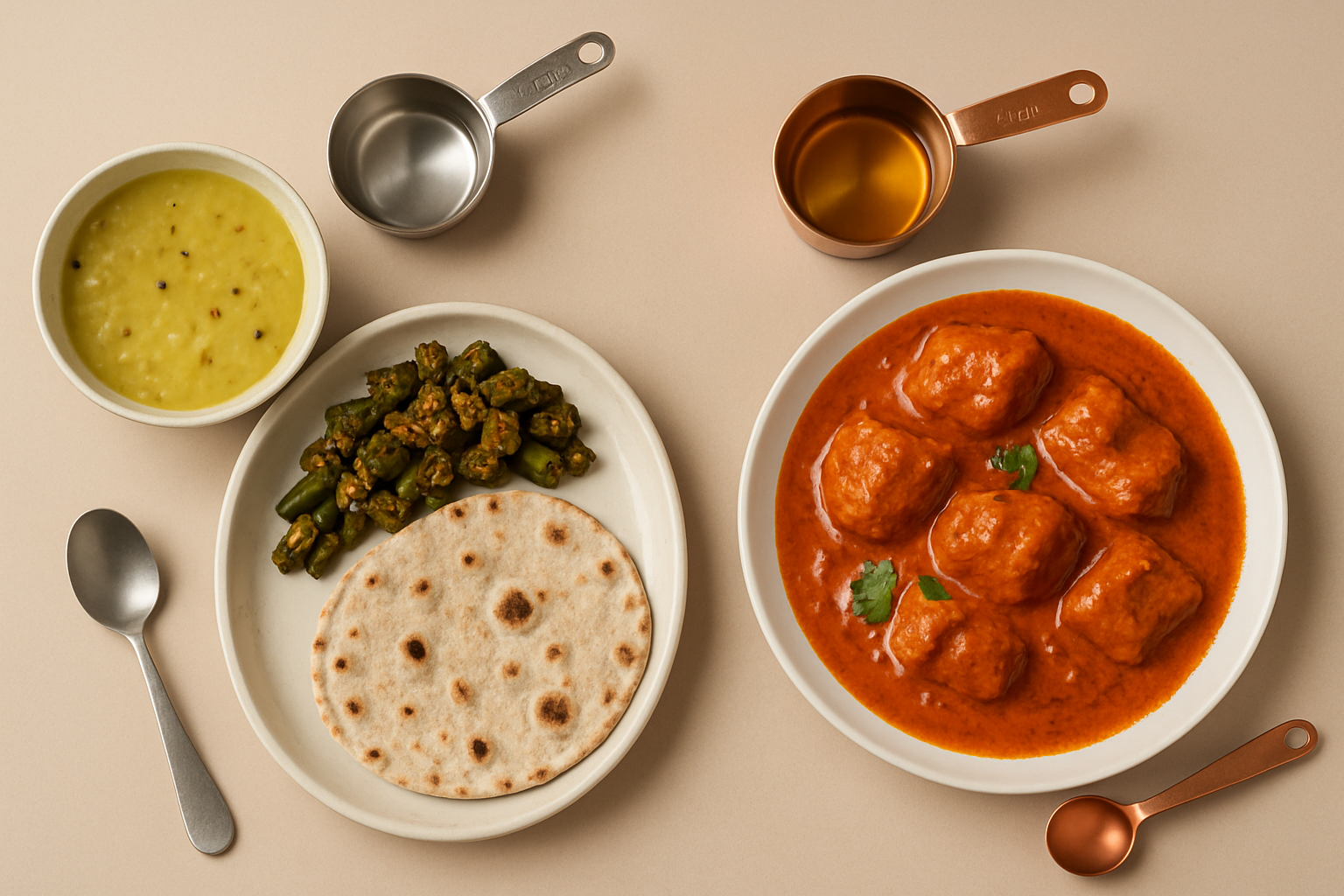 The difference between home-cooked and restaurant meals can be significant - both in taste and calories
The difference between home-cooked and restaurant meals can be significant - both in taste and calories
His story isn't unique. Think of my cousin, Priya, who was advised by her doctor to be more mindful of her diet to manage her PCOS. Priya loves aloo parathas - who doesn't? But logging a paratha is a nutritional puzzle. For comprehensive PCOS nutrition guidance, check our detailed PCOS food tracking guide which pairs perfectly with these calorie counting techniques. The final calorie count depends on:
- The size and density of the potato filling
- The generosity of the ghee or oil used for cooking
- The thickness of the dough
- Even the type of flour used
It felt less like a health strategy and more like a lottery. She felt defeated by the complexity before she could even begin.
Why Indian Food Tracking Feels Impossible
These stories resonate because they are the reality for so many of us. Indian cooking is an art form, not a standardized manufacturing process. Every household has its own version of a recipe, passed down through generations. The amount of oil that sizzles in a tadka, that extra spoonful of sugar to balance the tang in a Gujarati dal, or the loving dollop of white butter melting on a hot roti - these small, unmeasured acts of love dramatically change the nutritional profile of a dish.
This is our greatest challenge, but it's also our greatest strength. Our food is beautifully diverse and built on a foundation of fresh, whole ingredients. We don't need to abandon it; we just need a better, smarter way to understand and appreciate it.
From Fear to Facts: A New Perspective 📊
Let's demystify this with some simple, powerful facts. Did you know that a single tablespoon of any cooking oil - be it sunflower, mustard, coconut, or olive - contains roughly 120 calories? And a single teaspoon of sugar holds about 16 calories.
Think about that. If you use three tablespoons of oil to cook a sabzi for your family of four, you've added 360 calories to the pot before anything else has gone in. These "hidden" calories from cooking fats and sugars are often the biggest contributors to our daily energy intake, and we don't even notice them.
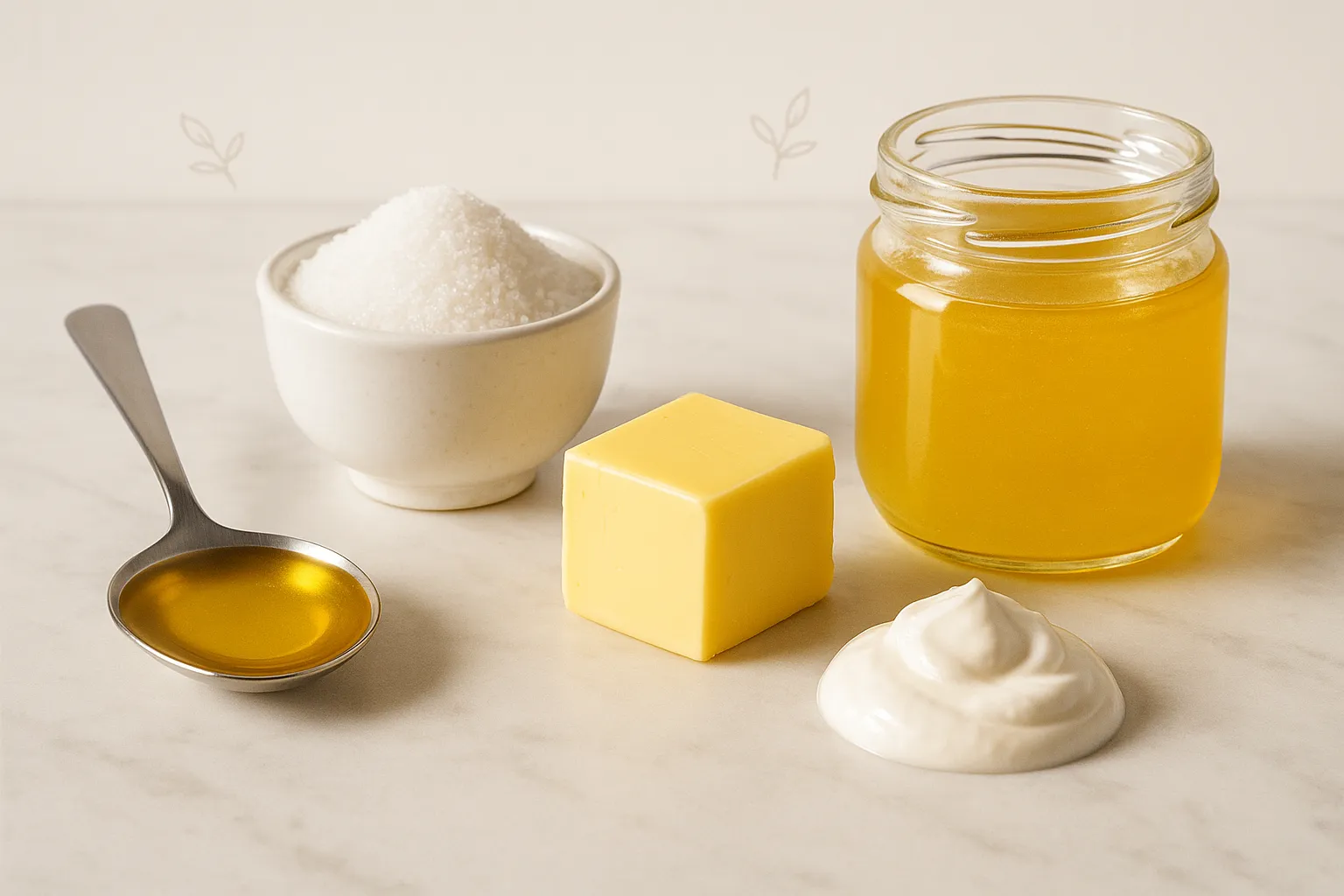 Figure 1: The hidden calorie sources in Indian cooking - oil is the biggest contributor
Figure 1: The hidden calorie sources in Indian cooking - oil is the biggest contributor
| Cooking Oil Type | Calories per Tablespoon |
|---|---|
| Sunflower Oil | 120 |
| Mustard Oil | 120 |
| Coconut Oil | 120 |
| Olive Oil | 120 |
| Ghee | 120 |
Table: Calorie comparison of common Indian cooking oils (per tablespoon)
But here's a fact that should make you proud: our traditional cooking methods are inherently healthy. Techniques like steaming (think soft idlis and fluffy dhoklas), roasting (tandoori items, roasted vegetables), and pressure cooking are fantastic for preserving nutrients while using minimal oil.
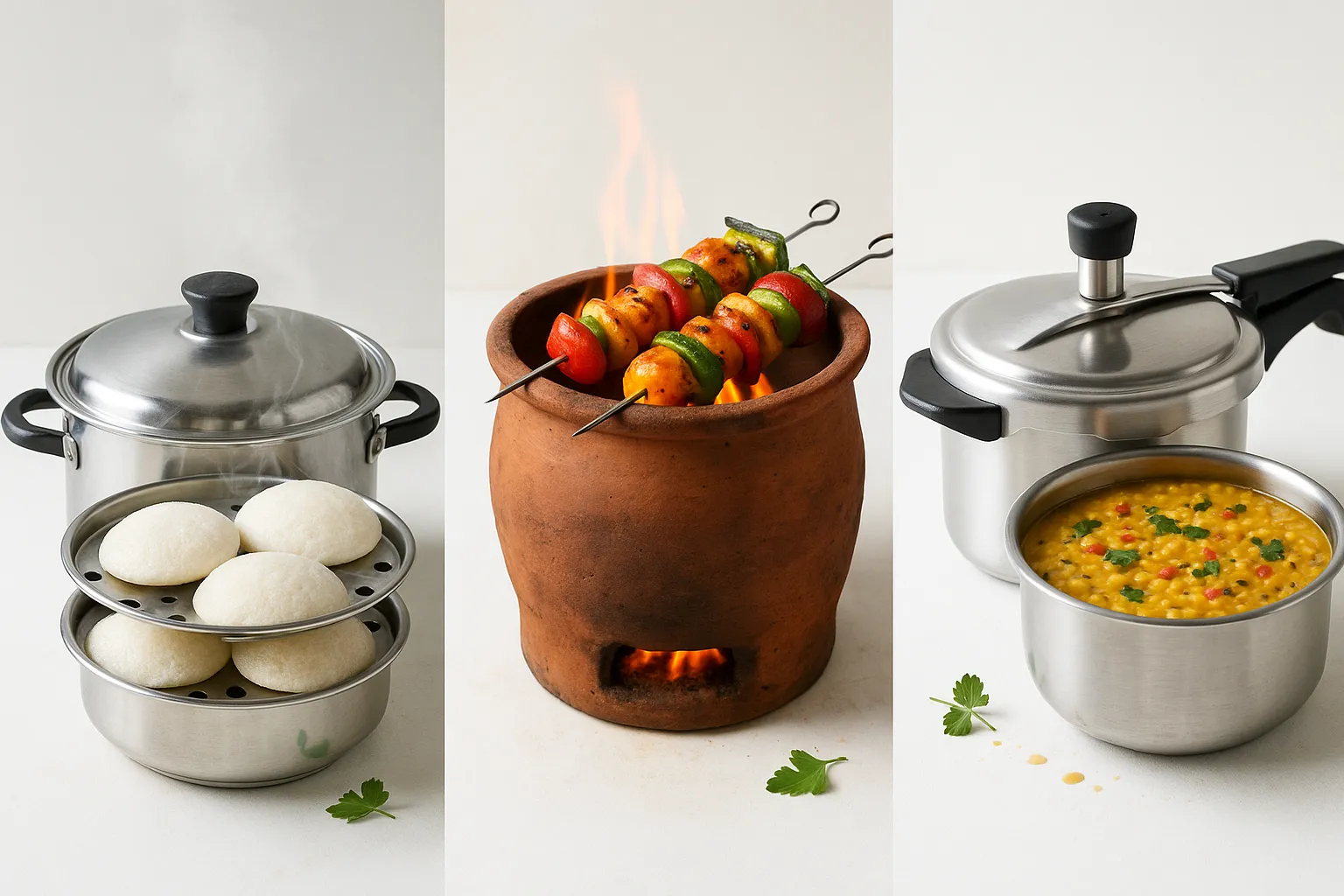 Figure 2: Traditional cooking methods like steaming and pressure cooking use significantly less oil
Figure 2: Traditional cooking methods like steaming and pressure cooking use significantly less oil
A fascinating study published in the Journal of Ethnic Foods highlighted that a typical Indian meal structure - a thali - often presents a well-balanced plate. It naturally incorporates:
- Carbohydrates from grains (roti, rice)
- High-quality proteins from lentils and legumes (dal, sambar)
- Essential fats from dairy and oils
- Vitamins and minerals from vegetables and spices
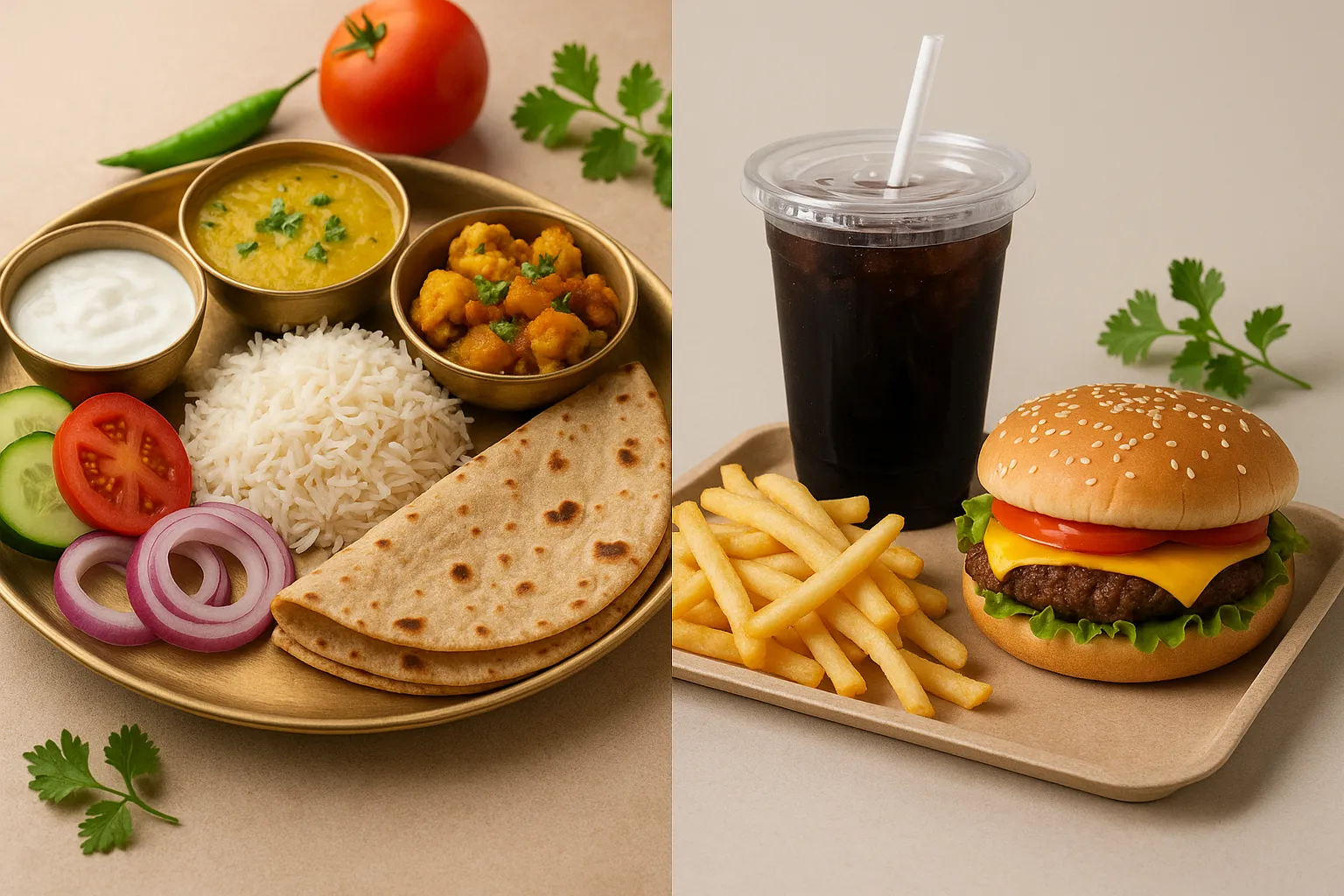 Figure 3: A traditional Indian thali is nutritionally superior to fast food in almost every aspect
Figure 3: A traditional Indian thali is nutritionally superior to fast food in almost every aspect
The problem is rarely the food itself, but the modern modifications - excessive oil, large portion sizes, and a reliance on refined grains.
My Personal Journey with Indian Food Tracking
My own health journey was a testament to this. For years, I believed that "eating healthy" meant giving up my favorite foods and surviving on bland, boring salads. It was a miserable thought. But then, I started to look closer at my own plate, not with judgment, but with curiosity.
I realized that my everyday meal of dal, a seasonal sabzi, a couple of rotis, and a side of yogurt and salad was already incredibly balanced. I didn't need a new diet; I needed new awareness. I didn't have to give up the food that was part of my identity. I just had to become more conscious of how it was prepared and how much of it I was consuming.
This simple shift in mindset was the real game-changer. It transformed my health journey from a chore I dreaded into a fascinating journey of self-discovery.
7 Actionable Tips to Master Your Meals 💡
Feeling a bit more empowered? Excellent. Let's translate that feeling into action. Here are seven simple, practical tips you can start using today to get a confident handle on the calories in your delicious, home-cooked Indian meals.
1. Become the Master of Your Oils and Fats 🥄
This is non-negotiable and the most impactful change you can make. Invest in a good set of measuring spoons (a tablespoon and a teaspoon are essential). Instead of free-pouring oil from the bottle, measure it.
Example: Let's say you're making a sabzi for a family of four and the recipe calls for 2 tablespoons of oil. That's 240 calories from oil. Divided among four people, that's 60 calories per person just from the cooking medium. Once you see this, you might consciously try using 1.5 tablespoons next time, instantly saving 60 calories from the total pot without anyone noticing the difference in taste.
2. Get Friendly with Your Kitchen Scale ⚖️
Before you start cooking, take two extra minutes to weigh your main ingredients. How many grams of raw moong dal are you using? How many grams of rice? How many potatoes are going into that curry?
A simple digital kitchen scale is an inexpensive but invaluable tool. It might feel like a tedious extra step initially, but I promise, it becomes a quick, easy habit. This step removes the biggest source of error in your calculations.
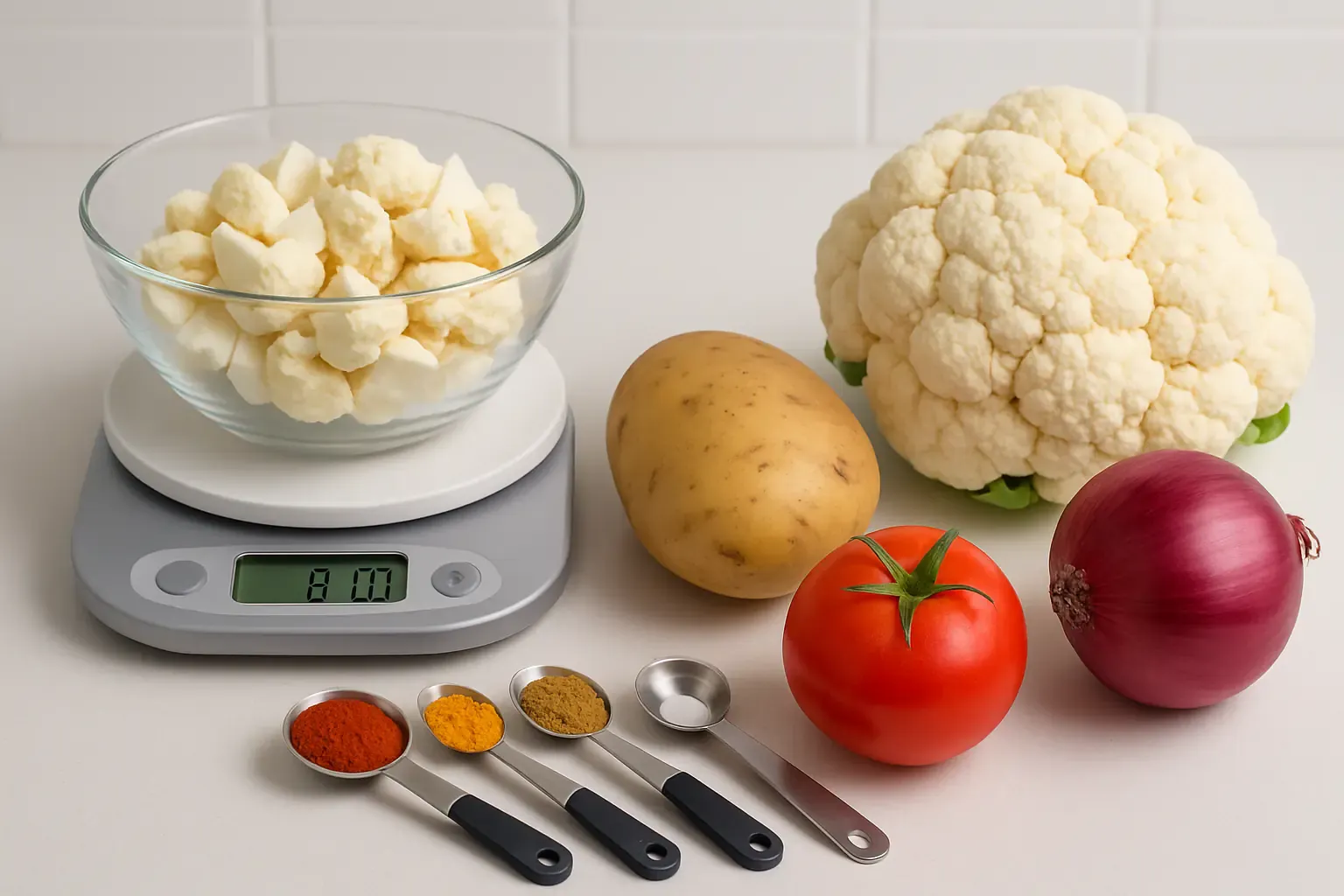 Measuring ingredients before cooking ensures accuracy in your calorie calculations
Measuring ingredients before cooking ensures accuracy in your calorie calculations
3. Create Your Personal "Recipe Bible" 📖
You likely cook your favorite dal, rajma, or chicken curry in a similar way each time. Take the time to calculate the total calories for your entire signature recipe once. Write it down in a notebook or a note on your phone.
Example: You calculate that your entire pot of dal has 1200 calories and it yields 6 standard servings. Voila! You now know that each serving of your dal is 200 calories. No more guessing with generic app entries.
4. Leverage Technology Wisely 📱
This is where a smart, culturally-aware app can be your best ally. An application like NutriScan is specifically designed for this challenge. You can simply take a picture of your meal, and its powerful AI can help:
- Identify the different components on your plate
- Estimate their quantities
- Provide a surprisingly accurate calorie count
It's built to understand the nuances of a thali, distinguishing between a katori of dal and a portion of sabzi. It does the heavy lifting for you.
5. Practice Mindful Portions with a Katori 🥣
The katori, that small, standard Indian bowl, is your secret weapon for portion control. Instead of serving yourself directly from the large cooking pot, which encourages overeating, dish out your dal and sabzi into katoris.
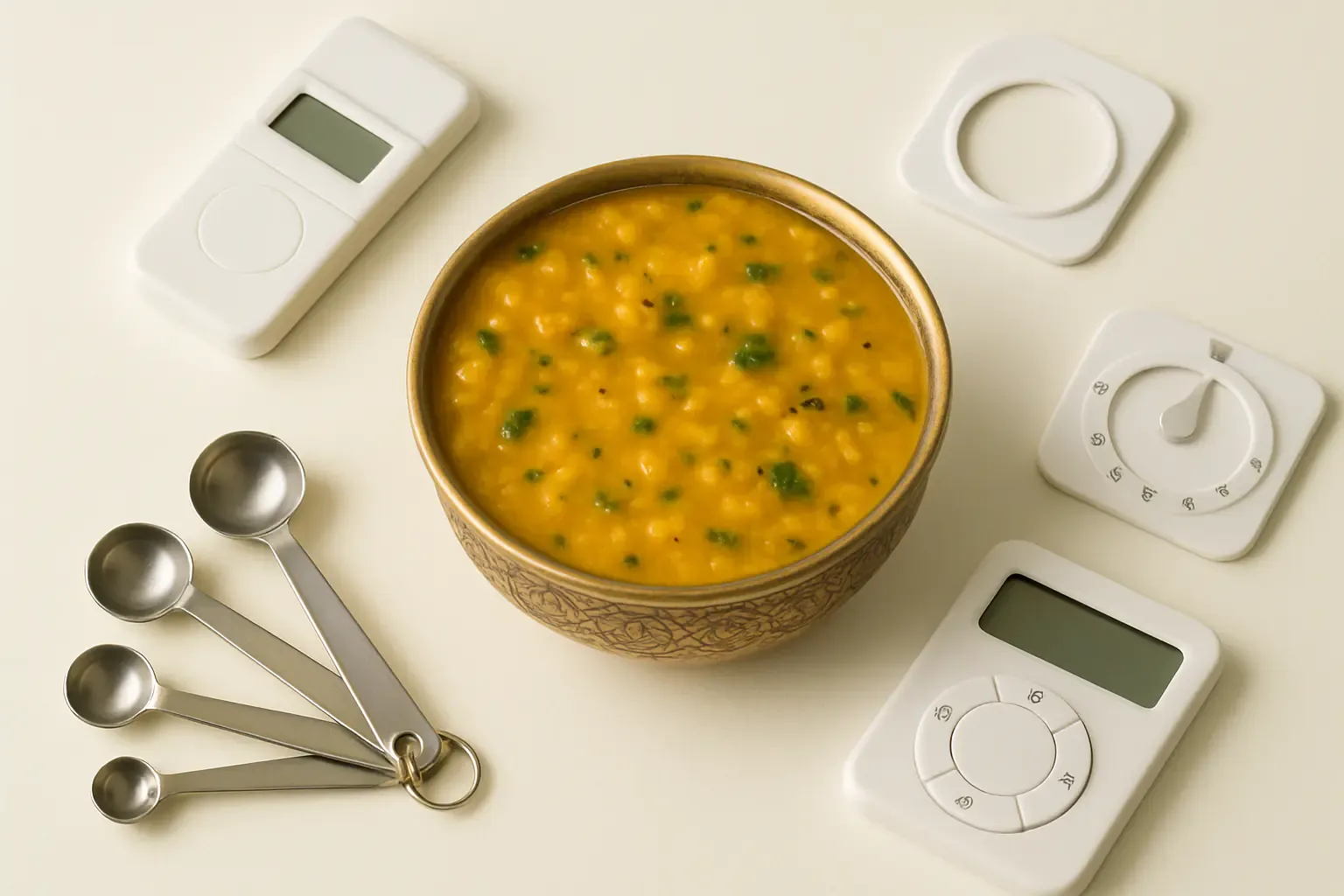 Using a katori standardizes portion sizes and promotes mindful eating
Using a katori standardizes portion sizes and promotes mindful eating
This simple act standardizes your portion sizes and makes you visually aware of how much you're eating. A standard katori of dal is a world away from a large, deep soup bowl filled to the brim.
6. Acknowledge the Little Extras 🍯
They say the devil is in the details, and in nutrition, the calories are in the extras. That tangy spoonful of mango pickle (achar), the crispy papad you munch on, the two biscuits you have with your evening chai, the small pinch of sugar you add to your yogurt - they all have calories.
They may seem insignificant individually, but they can easily add up to 100-200 calories over a day. Be honest and mindful in your tracking to get a true picture of your intake.
7. Embrace Progress, Not Perfection 🎯
This is perhaps the most important tip. You are not a laboratory machine. You will not be 100% accurate in your calculations, especially when you are just starting. And that is perfectly okay.
The goal is not to achieve flawless accounting but to foster awareness. If your daily estimate is off by 10-15%, you are still miles ahead of where you were when you were not tracking at all. Don't let the fear of being imperfect prevent you from starting this empowering process.
From Guesstimate to Estimate: A Practical Guide to Calculating Calories in Your Aloo Gobi 🥔
Talk is good, but action is better. Let's walk through a real-world calculation for one of the most beloved and common Indian dishes: Aloo Gobi. This is a simple, dry vegetable dish (sabzi) made with potatoes and cauliflower, a staple in many homes.
Step 1: Be a Detective - List and Weigh Your Raw Ingredients
First, get your kitchen scale and measuring spoons. We're preparing a dish that will serve two people.
Raw Ingredients:
- Cauliflower (Phool Gobi): 250 grams, florets separated
- Potato (Aloo): 150 grams, peeled and cubed
- Onion (Pyaaz): 100 grams, finely chopped (about one medium-sized onion)
- Tomato (Tamatar): 100 grams, chopped (about one medium tomato)
- Cooking Oil: 2 tablespoons (30ml)
- Ginger-Garlic Paste: 1 tablespoon (about 15 grams)
- Spices (turmeric, cumin seeds, coriander powder, garam masala, salt): The calorie contribution is minimal and can be safely ignored for practical estimation
Step 2: Do the Research - Find the Calorie Count for Each Ingredient
You can use a quick web search ("calories in 100g potato") or a reliable nutrition database. Here are the approximate values:
Calorie Breakdown:
- Cauliflower (250g): ~63 calories
- Potato (150g): ~116 calories
- Onion (100g): ~40 calories
- Tomato (100g): ~18 calories
- Cooking Oil (2 tbsp): ~240 calories (The most calorie-dense ingredient!)
- Ginger-Garlic Paste (1 tbsp): ~15 calories
Step 3: The Grand Total - Add Up All the Calories
Now, let's perform the simple addition: 63 + 116 + 40 + 18 + 240 + 15 = 492 calories
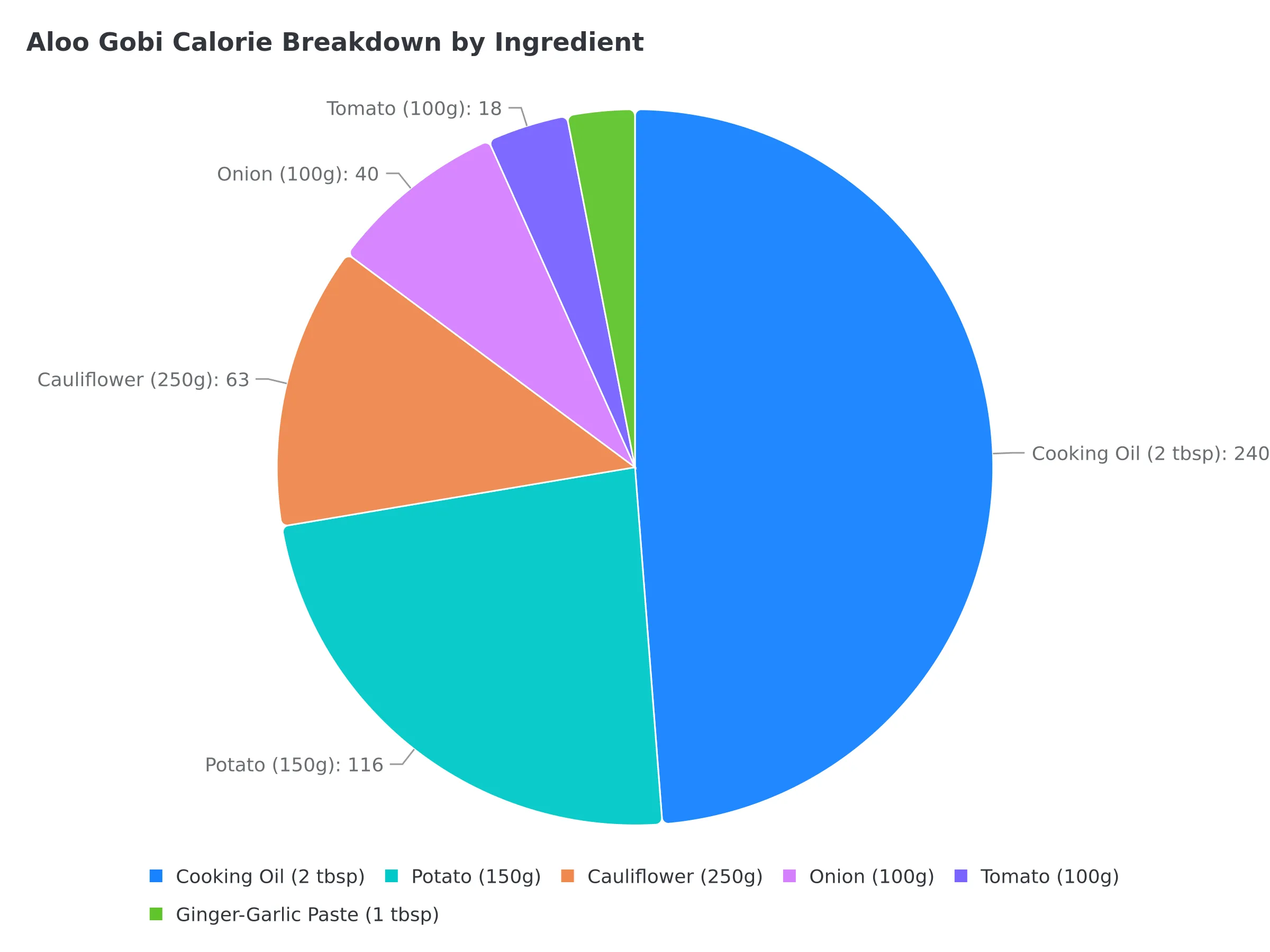 Figure 4: Aloo Gobi calorie breakdown - notice how cooking oil dominates the total
Figure 4: Aloo Gobi calorie breakdown - notice how cooking oil dominates the total
Step 4: Divide and Conquer - Calculate Calories Per Serving
This grand total of 492 calories is for the entire dish cooked in the pan. Since we established that this recipe serves two people, we simply divide the total by two:
492 ÷ 2 = 246 calories per serving
Step 5: Log, Learn, and Repeat
There you have it. A generous serving of your delicious, homemade Aloo Gobi contains approximately 246 calories. You can now log this with confidence in your food diary or app.
The beauty of this is that the next time you cook this dish using the same recipe, you don't need to repeat the entire calculation. You already have your number. You can slowly build a personal database for all your family's favorite recipes: your mom's rajma, your dad's chicken curry, your special bhindi sabzi. This is how you build a sustainable, accurate tracking habit.
What Modern Science and Research Tell Us 🔬
This methodical process of "deconstructing" a meal into its core components is not just a neat trick; it's a scientifically validated method for accurate nutritional assessment. The world of nutrition science is increasingly recognizing the need for culturally specific dietary tools.
Research Backing the Approach
A landmark 2023 study in The Lancet focusing on global dietary patterns strongly emphasized that for public health nutrition strategies to be effective, they must be supported by tools that can accurately assess local and traditional foods, moving beyond a one-size-fits-all, western-centric model.
Furthermore, the psychological benefits of this practice are well-documented. Research from the prestigious British Journal of Nutrition has consistently shown that the mere act of monitoring your food intake - even if it's not perfectly accurate - is strongly correlated with:
- Making better food choices
- Achieving long-term success in weight management
- Developing mindful eating habits
The process itself cultivates mindfulness. When you physically measure out one tablespoon of oil, you see it. This tangible awareness is often all the motivation you need to decide to use a little less next time, effortlessly saving calories without sacrificing the soul of the dish.
Traditional Cooking Methods and Nutrition
Another fascinating area of research involves how our traditional cooking methods affect nutrient availability. A study in the International Journal of Food Sciences and Nutrition found that pressure cooking lentils, a cornerstone of Indian cuisine, not only cooks them efficiently but can also increase the digestibility of their proteins.
This means your body can absorb and use the protein more effectively. So, when you're calculating the calories in your dal, you can also appreciate that you're preparing it in a way that maximizes its nutritional punch. It's a fantastic win-win.
The Power Is On Your Plate: You Are in Control 🌟
The idea of counting calories in diverse and complex Indian food can seem like a daunting mountain to climb. But it's not an unconquerable peak. Think of it as a skill, and like any new skill - learning to drive, learning a new language - it gets easier, faster, and more intuitive with practice.
It's about a fundamental shift in perspective: moving from vague guesswork to confident knowing. It's about understanding what goes into your body, one delicious ingredient at a time.
Remember my friend Rohan, who was once frustrated by the generic entries in his fitness app? He didn't give up on his goals. He just changed his method. He took an afternoon and used this step-by-step guide to calculate the calories in his mom's signature dal makhani. He was amazed by the result. It had fewer calories than the rich restaurant versions but more than the bland, watery ones in the app's database. He finally had a number that was his number, real and relevant to his life.
This single act of empowerment gave him the confidence to restart and succeed on his health journey.
You Don't Need to Change Your Culture
You do not need to abandon your culture or your culinary heritage to be healthy. You don't have to stop eating the food that brings you comfort and joy. You simply need to get to know it a little better. Every meal becomes an opportunity to learn. Every plate is a data point in your personal health story.
By embracing a little mindfulness and using the right tools, you can take complete control of your health, one delicious, home-cooked, and now, fully understood meal at a time.
Conclusion 📝
Counting calories in Indian home-cooked food doesn't have to be a mystery wrapped in frustration. With the right approach, tools, and mindset, you can transform this seemingly impossible task into an empowering daily practice.
The key is to start simple, be consistent, and remember that progress trumps perfection every time. Whether you're trying to lose weight, manage a health condition, or simply become more aware of your eating habits, understanding the nutritional content of your beloved Indian meals is not just possible - it's practical.
Your culinary heritage is not the enemy of your health goals. With a little knowledge, the right tools, and a systematic approach, you can honor both your culture and your well-being. The power to transform your health is literally on your plate.
Start with one recipe. Master it. Then move to the next. Before you know it, you'll have a complete understanding of your favorite meals, and tracking will become as natural as adding that perfect pinch of garam masala to your dal.
Frequently Asked Questions ❓
Q: This seems great for sabzi, but how do I count calories for a roti or chapati?
A: The calories in a roti depend on its size, thickness, and the type of flour used. A typical medium-sized (around 6-7 inches in diameter) whole wheat (atta) chapati, made from about 30 grams of dry flour, contains approximately 70-85 calories. If you spread a teaspoon of ghee or butter on it, add another 40-45 calories. The most accurate method? Weigh the dough ball for one roti before you roll it out. Once you do this a few times, you'll be able to estimate it by size and feel alone.
Q: What about when I eat out at an Indian restaurant or attend a wedding? How can I track that?
A: This is the ultimate challenge! Restaurant and celebration food is designed for indulgence, which often means more oil, butter, cream, and sugar. A practical rule of thumb is to estimate the calorie count to be 30-50% higher than your homemade version of the same dish. You can also make smarter choices: opt for tandoori or grilled items over creamy, gravy-based dishes, choose steamed rice over rich biryanis, and politely ask for dal or sabzi without the final flourish of butter or cream.
Q: This sounds like a lot of work. Do I really need to weigh and measure my food forever?
A: Absolutely not! That would be exhausting and would take the joy out of eating. The initial phase of weighing and measuring is a short-term training period. The goal is to train your eyes and your brain. After a few weeks of consistent practice, you will become incredibly adept at "eyeballing" your portion sizes. You'll instinctively know what 100 grams of cooked rice looks like on your plate. It's a temporary investment of effort that pays lifelong dividends.
Q: How exactly does an app like NutriScan simplify this entire process?
A: NutriScan is engineered to be the perfect solution to this very problem. It's like having a nutritionist in your pocket. Instead of doing manual calculations, you can simply snap a picture of your meal. The app's AI then identifies the different food items on your plate, estimates portion sizes based on visual cues, and provides a comprehensive nutritional breakdown in seconds. Its database is extensively trained on thousands of Indian dishes, making tracking effortless and consistent.
Q: Is counting calories the only thing that really matters for being healthy?
A: This is a critical point. No, calorie counting is not the only thing that matters. It's a very effective tool for managing your energy balance, but it's just one piece of the health puzzle. The quality of your calories is just as important as the quantity. For instance, 200 calories from a bowl of lentil soup and vegetables provide high-quality protein, fiber, vitamins, and minerals. 200 calories from fried chips provide mostly refined carbohydrates and unhealthy fats. Think of it this way: calorie counting helps you manage your food budget, but choosing nutrient-dense foods ensures you're making wise investments in your long-term health.
Q: Can I use this method for all types of Indian regional cuisines?
A: Absolutely! This method works for all regional Indian cuisines - whether it's South Indian sambar and rasam, Bengali fish curry, Punjabi makki di roti, or Gujarati dhokla. The principle remains the same: identify ingredients, measure quantities, calculate individual calories, and sum them up. The beauty is that once you understand the process, you can apply it to any dish from any region.
Q: What if my family uses different cooking methods or ingredients than what I calculated?
A: This is completely normal! The key is to recalculate whenever there's a significant change in ingredients or cooking methods. For example, if your mom usually uses 2 tablespoons of oil but today used 3 tablespoons, add an extra 120 calories to your total. If she used coconut oil instead of sunflower oil, the calorie count remains similar (around 120 calories per tablespoon), but the nutritional profile might be slightly different. The goal is awareness, not perfection.
Q: How do I handle mixed dishes like biryani or pulao where everything is cooked together?
A: Mixed dishes can be tricky, but the principle remains the same. List all ingredients that go into the entire pot (rice, meat/vegetables, oil, ghee, yogurt, spices), calculate the total calories, and divide by the number of servings. For biryani, don't forget to include the ghee used for layering, the fried onions, and the yogurt in the marinade. It might seem complex initially, but once you calculate it for your family's recipe, you'll have the number for future reference.

 ChatGPT
ChatGPT  Claude
Claude  AI Mode
AI Mode  Perplexity
Perplexity 